Evaluation and Comparison of Reanalysis Data for Runoff Simulation in the Data-Scarce Watersheds of Alpine Regions
Abstract
1. Introduction
2. Materials and Methods
2.1. Study Area
2.2. Data Sources and Processing
2.3. SWAT Model
2.3.1. Hydrological Cycle Processes in SWAT Model
2.3.2. Snowmelt Processes in SWAT Model
2.3.3. Model Setup
2.4. Statistical Measures
2.4.1. Validation Strategies
2.4.2. Validation Metrics
3. Results
3.1. Climate Aspect
3.1.1. Evaluation of the Precipitation of Reanalysis Datasets by Time Scale
3.1.2. Evaluation of the Temperature of Reanalysis Datasets by Time Scale
3.1.3. Spatial Annual Averages: Reanalysis Datasets vs. OBS Data
3.2. Hydrological Aspect
3.2.1. Calibration and Sensitivity Analysis of Parameters
3.2.2. Flow Simulation in the SYYR
4. Discussion
4.1. Uncertainty Analysis of Reanalysis Data
4.2. Optimization of the CMADS Dataset
4.3. Limitations
5. Conclusions
- (1)
- On the daily scale, in terms of climate, CMFD performs best (i.e., correlation over 0.95 and RMSD less than 1 mm/day), followed by ERA5 and CFSR, while CMADS performs poorly in terms of daily precipitation (i.e., correlation only 0.74). The four reanalysis datasets performed well in terms of temperature at the daily and monthly scales (i.e., correlation over 0.95), but not satisfactorily at the annual scales.
- (2)
- In runoff simulations, SWAT has better simulation accuracy at the monthly scale than at the daily scale. The best runoff simulation was based on OBS data (with R2 > 0.80, NSE > 0.80 during the calibration period), and the closest to the OBS simulation results was CMFD, followed by ERA5 and CFSR, while CMADS was the worst performer.
- (3)
- Reanalysis data and the observed data in most cases underestimated the peak flows to varying degrees in the runoff simulations carried out, and failed to effectively capture the extreme runoff characteristics of the basin, both at the source of the Yellow River and the Yangtze.
- (4)
- After optimizing CMADS with the AIMERG precipitation dataset, the runoff simulation performance was greatly improved, with R2 and NSE increasing from 0.55 and 0.54 to 0.86 and 0.86 for the source of the Yangtze at the monthly scale and from 0.53 and 0.50 to 0.82 and 0.79 at the daily scale, respectively.
Author Contributions
Funding
Data Availability Statement
Conflicts of Interest
References
- Wang, T.; Sun, B.; Wang, H. Interannual variations of monthly precipitation and associated mechanisms over the Three River Source region in China in winter months. Int. J. Climatol. 2021, 41, 2209–2225. [Google Scholar] [CrossRef]
- Jiang, C.; Zhang, L. Effect of ecological restoration and climate change on ecosystems: A case study in the Three-Rivers Headwater Region, China. Environ. Monit. Assess. 2016, 188, 382. [Google Scholar] [CrossRef] [PubMed]
- Liu, J.; Xu, X.; Shao, Q. Grassland degradation in the “Three-River Headwaters” region, Qinghai Province. J. Geogr. Sci. 2008, 18, 259–273. [Google Scholar] [CrossRef]
- Yang, K.; Wu, H.; Qin, J.; Lin, C.; Tang, W.; Chen, Y. Recent climate changes over the Tibetan Plateau and their impacts on energy and water cycle: A review. Glob. Planet. Chang. 2014, 112, 79–91. [Google Scholar] [CrossRef]
- Wang, Y.; Xie, X.; Shi, J.; Zhu, B. Ensemble runoff modeling driven by multi-source precipitation products over the Tibetan Plateau. Chin. Sci. Bull. 2021, 66, 4169–4186. [Google Scholar] [CrossRef]
- Ji, P.; Yuan, X. High-Resolution Land Surface Modeling of Hydrological Changes over the Sanjiangyuan Region in the Eastern Tibetan Plateau: 2. Impact of Climate and Land Cover Change. J. Adv. Model. Earth Syst. 2018, 10, 2829–2843. [Google Scholar] [CrossRef]
- Li, F.; Zhang, Y.; Xu, Z.; Liu, C.; Zhou, Y.; Liu, W. Runoff predictions in ungauged catchments in southeast Tibetan Plateau. J. Hydrol. 2014, 511, 28–38. [Google Scholar] [CrossRef]
- Sun, Y.; Bao, W.; Jiang, P.; Xu, Y.; He, C.; Chen, W.; Huang, L. Real-time updating of XAJ model by using Unscented Kalman Filter. J. Lake Sci. 2018, 30, 488–496. [Google Scholar]
- Dal Molin, M.; Schirmer, M.; Zappa, M.; Fenicia, F. Understanding dominant controls on streamflow spatial variability to set up a semi-distributed hydrological model: The case study of the Thur catchment. Hydrol. Earth Syst. Sci. 2020, 24, 1319–1345. [Google Scholar] [CrossRef]
- Liu, Y.; Zhou, Z.; Liu, J.; Wang, P.; Li, Y.; Zhu, Y.; Jiang, X.; Wang, K.; Wang, F. Distributed hydrological model of the Qinghai Tibet Plateau based on the hydrothermal coupling: II: Simulation of water cycle processes in the Niyang River basin considering glaciers and frozen soils? Adv. Water Sci. 2021, 32, 201–210. [Google Scholar]
- Goyal, M.K.; Panchariya, V.K.; Sharma, A.; Singh, V. Comparative Assessment of SWAT Model Performance in two Distinct Catchments under Various DEM Scenarios of Varying Resolution, Sources and Resampling Methods. Water Resour. Manag. 2018, 32, 805–825. [Google Scholar] [CrossRef]
- Grusson, Y.; Anctil, F.; Sauvage, S.; Sánchez Pérez, J. Testing the SWAT Model with Gridded Weather Data of Different Spatial Resolutions. Water 2017, 9, 54. [Google Scholar] [CrossRef]
- Eini, M.R.; Javadi, S.; Delavar, M.; Monteiro, J.A.F.; Darand, M. High accuracy of precipitation reanalyses resulted in good river discharge simulations in a semi-arid basin. Ecol. Eng. 2019, 131, 107–119. [Google Scholar] [CrossRef]
- You, Q.; Kang, S.; Li, J.; Chen, D.; Zhai, P.; Ji, Z. Several research frontiers of climate change over the Tibetan Plateau. J. Glaciol. 2021, 43, 885–901. [Google Scholar]
- Sun, Q.; Miao, C.; Duan, Q.; Ashouri, H.; Sorooshian, S.; Hsu, K.L. A Review of Global Precipitation Data Sets: Data Sources, Estimation, and Intercomparisons. Rev. Geophys. 2018, 56, 79–107. [Google Scholar] [CrossRef]
- Tan, M.L.; Gassman, P.W.; Liang, J.; Haywood, J.M. A review of alternative climate products for SWAT modelling: Sources, assessment and future directions. Sci. Total Environ. 2021, 795, 148915. [Google Scholar] [CrossRef] [PubMed]
- Bosilovich, M.G.; Chen, J.; Robertson, F.R.; Adler, R.F. Evaluation of Global Precipitation in Reanalyses. J. Appl. Meteorol. Clim. 2008, 47, 2279–2299. [Google Scholar] [CrossRef]
- Ndhlovu, G.Z.; Woyessa, Y.E. Use of gridded climate data for hydrological modelling in the Zambezi River Basin, Southern Africa. J. Hydrol. 2021, 602, 126749. [Google Scholar] [CrossRef]
- Qi, D.; Zhang, S.; Li, Y. Research Progress on Variations of the Climate and Water Resourcesin the Source Region of the Yangtze River. Plateau Mt. Meteorol. Res. 2013, 33, 89–96. [Google Scholar]
- Jin, J.; Wang, G.; Zhang, J.; Yang, Q.; Liu, C.; Liu, Y.; Bao, Z.; He, R. Impacts of climate change on hydrology in the Yellow River source region, China. J. Water Clim. Chang. 2020, 11, 916–930. [Google Scholar] [CrossRef]
- Meng, X.; Wang, H.; Chen, J. Profound Impacts of the China Meteorological Assimilation Driving Datasets for the SWAT Model (CMADS). Water 2019, 11, 832. [Google Scholar] [CrossRef]
- Fuka, D.R.; Walter, M.T.; MacAlister, C.; Degaetano, A.T.; Steenhuis, T.S.; Easton, Z.M. Using the Climate Forecast System Reanalysis as weather input data for watershed models. Hydrol. Process. 2014, 28, 5613–5623. [Google Scholar] [CrossRef]
- Ma, Z.; Xu, J.; Zhu, S.; Yang, J.; Tang, G.; Yang, Y.; Shi, Z.; Hong, Y. AIMERG: A new Asian precipitation dataset (0.1 degrees/half-hourly, 2000–2015) by calibrating the GPM-era IMERG at a daily scale using APHRODITE. Earth Syst. Sci. Data 2020, 12, 1525–1544. [Google Scholar] [CrossRef]
- Havrylenko, S.B.; Bodoque, J.M.; Srinivasan, R.; Zucarelli, G.V.; Mercuri, P. Assessment of the soil water content in the Pampas region using SWAT. Catena 2016, 137, 298–309. [Google Scholar] [CrossRef]
- Awan, U.K.; Ismaeel, A. A new technique to map groundwater recharge in irrigated areas using a SWAT model under changing climate. J. Hydrol. 2014, 519, 1368–1382. [Google Scholar] [CrossRef]
- Kondo, T.; Sakai, N.; Yazawa, T.; Shimizu, Y. Verifying the applicability of SWAT to simulate fecal contamination for watershed management of Selangor River, Malaysia. Sci. Total Environ. 2021, 774, 145075. [Google Scholar] [CrossRef]
- Lin, F.; Chen, X.; Yao, W.; Fang, Y.; Deng, H.; Wu, J.; Lin, B. Multi-time scale analysis of water conservation in a discontinuous forest watershed based on SWAT model. Acta Geogr. Sin. 2020, 75, 1065–1078. [Google Scholar]
- Pombo, S.; de Oliveira, R.P. Evaluation of extreme precipitation estimates from TRMM in Angola. J. Hydrol. 2015, 523, 663–679. [Google Scholar] [CrossRef]
- Tan, M.; Duan, Z. Assessment of GPM and TRMM Precipitation Products over Singapore. Remote Sens. 2017, 9, 720. [Google Scholar] [CrossRef]
- Xu, Z.; Han, Y. Short communication comments on ‘DISO: A rethink of Taylor diagram’. Int. J. Climatol. 2020, 40, 2506–2510. [Google Scholar] [CrossRef]
- Pomee, M.S.; Hertig, E. Precipitation projections over the Indus River Basin of Pakistan for the 21st century using a statistical downscaling framework. Int. J. Climatol. 2022, 42, 289–314. [Google Scholar] [CrossRef]
- Randriatsara, H.H.R.H.; Hu, Z.; Xu, X.; Ayugi, B.; Sian, K.T.C.L.; Mumo, R.; Ongoma, V. Evaluation of gridded precipitation datasets over Madagascar. Int. J. Climatol. 2022, 42, 7028–7046. [Google Scholar] [CrossRef]
- Tang, G.; Clark, M.P.; Papalexiou, S.M.; Ma, Z.; Hong, Y. Have satellite precipitation products improved over last two decades? A comprehensive comparison of GPM IMERG with nine satellite and reanalysis datasets. Remote Sens. Environ. 2020, 240, 111697. [Google Scholar] [CrossRef]
- Moriasi, D.N.; Gitau, M.W.; Pai, N.; Daggupati, P. Hydrologic and Water Quality Models: Performance Measures and Evaluation Criteria. Trans. ASABE 2015, 58, 1763–1785. [Google Scholar]
- Abbaspour, K.C.; Rouholahnejad, E.; Vaghefi, S.; Srinivasan, R.; Yang, H.; Kløve, B. A continental-scale hydrology and water quality model for Europe: Calibration and uncertainty of a high-resolution large-scale SWAT model. J. Hydrol. 2015, 524, 733–752. [Google Scholar] [CrossRef]
- Chen, X.; Chen, W.; Huang, G. Future Climatic Projections and Hydrological Responses in the Upper Beijiang River Basin of South China Using Bias-Corrected RegCM 4.6 Data. J. Geophys. Res. Atmos. 2021, 126, e2021JD034550. [Google Scholar] [CrossRef]
- Mararakanye, N.; Le Roux, J.J.; Franke, A.C. Using satellite-based weather data as input to SWAT in a data poor catchment. Phys. Chem. Earth Parts A/B/C 2020, 117, 102871. [Google Scholar] [CrossRef]
- Dhanesh, Y.; Bindhu, V.M.; Senent-Aparicio, J.; Brighenti, T.M.; Ayana, E.; Smitha, P.S.; Fei, C.; Srinivasan, R. A Comparative Evaluation of the Performance of CHIRPS and CFSR Data for Different Climate Zones Using the SWAT Model. Remote Sens. 2020, 12, 3088. [Google Scholar] [CrossRef]
- Baatz, R.; Hendricks Franssen, H.J.; Euskirchen, E.; Sihi, D.; Dietze, M.; Ciavatta, S.; Fennel, K.; Beck, H.; De Lannoy, G.; Pauwels, V.R.N.; et al. Reanalysis in Earth System Science: Toward Terrestrial Ecosystem Reanalysis. Rev. Geophys. 2021, 59, e2020RG000715. [Google Scholar] [CrossRef]
- Zhang, H.; Yang, T.; Bah, A.; Luo, Z.; Chen, G.; Xie, Y. Analysis of the Applicability of Multisource Meteorological Precipitation Data in the Yunnan-Kweichow-Plateau Region at Multiple Scales. Atmosphere 2023, 14, 701. [Google Scholar] [CrossRef]
- Pepin, N.C.; Arnone, E.; Gobiet, A.; Haslinger, K.; Kotlarski, S.; Notarnicola, C.; Palazzi, E.; Seibert, P.; Serafin, S.; Schöner, W.; et al. Climate Changes and Their Elevational Patterns in the Mountains of the World. Rev. Geophys. 2022, 60, e2020RG000730. [Google Scholar] [CrossRef]
- Hao, Y.; Baik, J.; Choi, M. Combining generalized complementary relationship models with the Bayesian Model Averaging method to estimate actual evapotranspiration over China. Agric. For. Meteorol. 2019, 279, 107759. [Google Scholar] [CrossRef]
- He, J.; Yang, K.; Tang, W.; Lu, H.; Qin, J.; Chen, Y.; Li, X. The first high-resolution meteorological forcing dataset for land process studies over China. Sci. Data 2020, 7, 25. [Google Scholar] [CrossRef]
- Jiang, C.; Xu, T.; Wang, S.; Nie, W.; Sun, Z. Evaluation of Zenith Tropospheric Delay Derived from ERA5 Data over China Using GNSS Observations. Remote Sens. 2020, 12, 663. [Google Scholar] [CrossRef]
- Li, H.; Chen, R.; Han, C.; Yang, Y. Evaluation of the Spatial and Temporal Variations of Condensation and Desublimation over the Qinghai–Tibet Plateau Based on Penman Model Using Hourly ERA5-Land and ERA5 Reanalysis Datasets. Remote Sens. 2022, 14, 5815. [Google Scholar] [CrossRef]
- Hersbach, H.; Bell, B.; Berrisford, P.; Hirahara, S.; Horányi, A.; Muñoz Sabater, J.; Nicolas, J.; Peubey, C.; Radu, R.; Schepers, D.; et al. The ERA5 global reanalysis. Q. J. R. Meteorol. Soc. 2020, 146, 1999–2049. [Google Scholar] [CrossRef]
- Saha, S.; Moorthi, S.; Wu, X.; Wang, J.; Nadiga, S.; Tripp, P.; Behringer, D.; Hou, Y.; Chuang, H.; Iredell, M.; et al. The NCEP Climate Forecast System Version 2. J. Clim. 2014, 27, 2185–2208. [Google Scholar] [CrossRef]
- Ghimire, U.; Akhtar, T.; Shrestha, N.K.; Paul, P.K.; Schürz, C.; Srinivasan, R.; Daggupati, P. A Long-term Global Comparison of IMERG and CFSR with Surface Precipitation Stations. Water Resour. Manag. 2022, 36, 5695–5709. [Google Scholar] [CrossRef]
- Zhang, L.; Meng, X.; Wang, H.; Yang, M.; Cai, S. Investigate the Applicability of CMADS and CFSR Reanalysis in Northeast China. Water 2020, 12, 996. [Google Scholar] [CrossRef]
- Dao, D.M.; Lu, J.; Chen, X.; Kantoush, S.A.; Binh, D.V.; Phan, P.; Tung, N.X. Predicting Tropical Monsoon Hydrology Using CFSR and CMADS Data over the Cau River Basin in Vietnam. Water 2021, 13, 1314. [Google Scholar] [CrossRef]
- Ma, B.; Zeng, W.; Xie, Y.; Wang, Z.; Hu, G.; Li, Q.; Cao, R.; Zhuo, Y.; Zhang, T. Boundary delineation and grading functional zoning of Sanjiangyuan National Park based on biodiversity importance evaluations. Sci. Total Environ. 2022, 825, 154068. [Google Scholar] [CrossRef] [PubMed]
- Wang, L.; Yao, T.; Chai, C.; Cuo, L.; Su, F.; Zhang, F.; Yao, Z.; Zhang, Y.; Li, X.; Qi, J.; et al. Monitoring and Quantifying Total River Runoff from the Third Pole. Bull. Am. Meteorol. Soc. 2020, 5, E948–E965. [Google Scholar] [CrossRef]
- Li, W.Z.; Liu, W.; Zhang, T.F. The contribution rate of climate and human activities on runoff change in the source regions of Yellow River. J. Glaciol. Geocryol. 2018, 40, 958–992. [Google Scholar]
- Guo, H.; Chen, S.; Bao, A.; Behrangi, A.; Hong, Y.; Ndayisaba, F.; Hu, J.; Stepanian, P.M. Early assessment of Integrated Multi-satellite Retrievals for Global Precipitation Measurement over China. Atmos. Res. 2016, 176–177, 121–133. [Google Scholar] [CrossRef]
- Tang, G.; Ma, Y.; Long, D.; Zhong, L.; Hong, Y. Evaluation of GPM Day-1 IMERG and TMPA Version-7 legacy products over Mainland China at multiple spatiotemporal scales. J. Hydrol. 2016, 533, 152–167. [Google Scholar] [CrossRef]
- Tang, G.; Zeng, Z.; Long, D.; Guo, X.; Yong, B.; Zhang, W.; Hong, Y. Statistical and Hydrological Comparisons between TRMM and GPM Level-3 Products over a Midlatitude Basin: Is Day-1 IMERG a Good Successor for TMPA 3B42V7? J. Hydrometeorol. 2016, 17, 121–137. [Google Scholar] [CrossRef]
- Zhang, L.; Gao, L.; Chen, J.; Zhao, L.; Zhao, J.; Qiao, Y.; Shi, J. Comprehensive evaluation of mainstream gridded precipitation datasets in the cold season across the Tibetan Plateau. J. Hydrol. Reg. Stud. 2022, 43, 101186. [Google Scholar] [CrossRef]
- Sengupta, A.; Vissa, N.K.; Roy, I. Assessing the performance of satellite derived and reanalyses data in capturing seasonal changes in extreme precipitation scaling rates over the Indian subcontinent. Atmos. Res. 2023, 288, 106741. [Google Scholar] [CrossRef]
- Peña-Arancibia, J.L.; van Dijk, A.I.J.M.; Renzullo, L.J.; Mulligan, M. Evaluation of Precipitation Estimation Accuracy in Reanalyses, Satellite Products, and an Ensemble Method for Regions in Australia and South and East Asia. J. Hydrometeorol. 2013, 14, 1323–1333. [Google Scholar] [CrossRef]
- Hu, Z.; Chai, L.; Crow, W.T.; Liu, S.; Zhu, Z.; Zhou, J.; Qu, Y.; Liu, J.; Yang, S.; Lu, Z. Applying a Wavelet Transform Technique to Optimize General Fitting Models for SM Analysis: A Case Study in Downscaling over the Qinghai–Tibet Plateau. Remote Sens. 2022, 14, 3063. [Google Scholar] [CrossRef]
- Zerenner, T.; Venema, V.; Friederichs, P.; Simmer, C. Multi-objective downscaling of precipitation time series by genetic programming. Int. J. Climatol. 2021, 41, 6162–6182. [Google Scholar] [CrossRef]
- Horton, P.; Jaboyedoff, M.; Obled, C. Using genetic algorithms to optimize the analogue method for precipitation prediction in the Swiss Alps. J. Hydrol. 2018, 556, 1220–1231. [Google Scholar] [CrossRef]
- Islam, K.I.; Elias, E.; Carroll, K.C.; Brown, C. Exploring Random Forest Machine Learning and Remote Sensing Data for Streamflow Prediction: An Alternative Approach to a Process-Based Hydrologic Modeling in a Snowmelt-Driven Watershed. Remote Sens. 2023, 15, 3999. [Google Scholar] [CrossRef]
- Fernandez-Palomino, C.A.; Hattermann, F.F.; Krysanova, V.; Lobanova, A.; Vega-Jácome, F.; Lavado, W.; Santini, W.; Aybar, C.; Bronstert, A. A novel high-resolution gridded precipitation dataset for Peruvian and Ecuadorian watersheds—Development and hydrological evaluation. J. Hydrometeorol. 2022, 23, 309–336. [Google Scholar]
- Wang, T.; Yang, H.; Yang, D.; Qin, Y.; Wang, Y. Quantifying the streamflow response to frozen ground degradation in the source region of the Yellow River within the Budyko framework. J. Hydrol. 2018, 558, 301–313. [Google Scholar] [CrossRef]
- Xin, J.; Sun, X.; Liu, L.; Li, H.; Liu, X.; Li, X.; Cheng, L.; Xu, Z. Quantifying the contribution of climate and underlying surface changes to alpine runoff alterations associated with glacier melting. Hydrol. Process. 2021, 35, e14069. [Google Scholar] [CrossRef]
- Qin, Y.; Yang, D.; Gao, B.; Wang, T.; Chen, J.; Chen, Y.; Wang, Y.; Zheng, G. Impacts of climate warming on the frozen ground and eco-hydrology in the Yellow River source region, China. Sci. Total Environ. 2017, 605–606, 830–841. [Google Scholar] [CrossRef] [PubMed]
- Cherkauer, K.A.; Lettenmaier, D.P. Hydrologic effects of frozen soils in the upper Mississippi River basin. J. Geophys. Res. 1999, 104, 19599–19610. [Google Scholar] [CrossRef]
- Bense, V.F.; Kooi, H.; Ferguson, G.; Read, T. Permafrost degradation as a control on hydrogeological regime shifts in a warming climate. J. Geophys. Res. Earth Surf. 2012, 117. [Google Scholar] [CrossRef]
- Cheng, G.; Jin, H. Permafrost and groundwater on the Qinghai-Tibet Plateau and in northeast China. Hydrogeol. J. 2013, 21, 5–23. [Google Scholar] [CrossRef]
- Omani, N.; Srinivasan, R.; Smith, P.K.; Karthikeyan, R. Glacier mass balance simulation using SWAT distributed snow algorithm. Hydrol. Sci. J. 2017, 62, 546–560. [Google Scholar] [CrossRef]
- Qi, J.; Li, S.; Li, Q.; Xing, Z.; Bourque, C.P.A.; Meng, F. A new soil-temperature module for SWAT application in regions with seasonal snow cover. J. Hydrol. 2016, 538, 863–877. [Google Scholar] [CrossRef]
- Zhang, H.; Wang, B.; Liu, D.L.; Zhang, M.; Leslie, L.M.; Yu, Q. Using an improved SWAT model to simulate hydrological responses to land use change: A case study of a catchment in tropical Australia. J. Hydrol. 2020, 585, 124822. [Google Scholar] [CrossRef]
- Bui, M.T.; Lu, J.; Nie, L. A Review of Hydrological Models Applied in the Permafrost-Dominated Arctic Region. Geosciences 2020, 10, 401. [Google Scholar] [CrossRef]

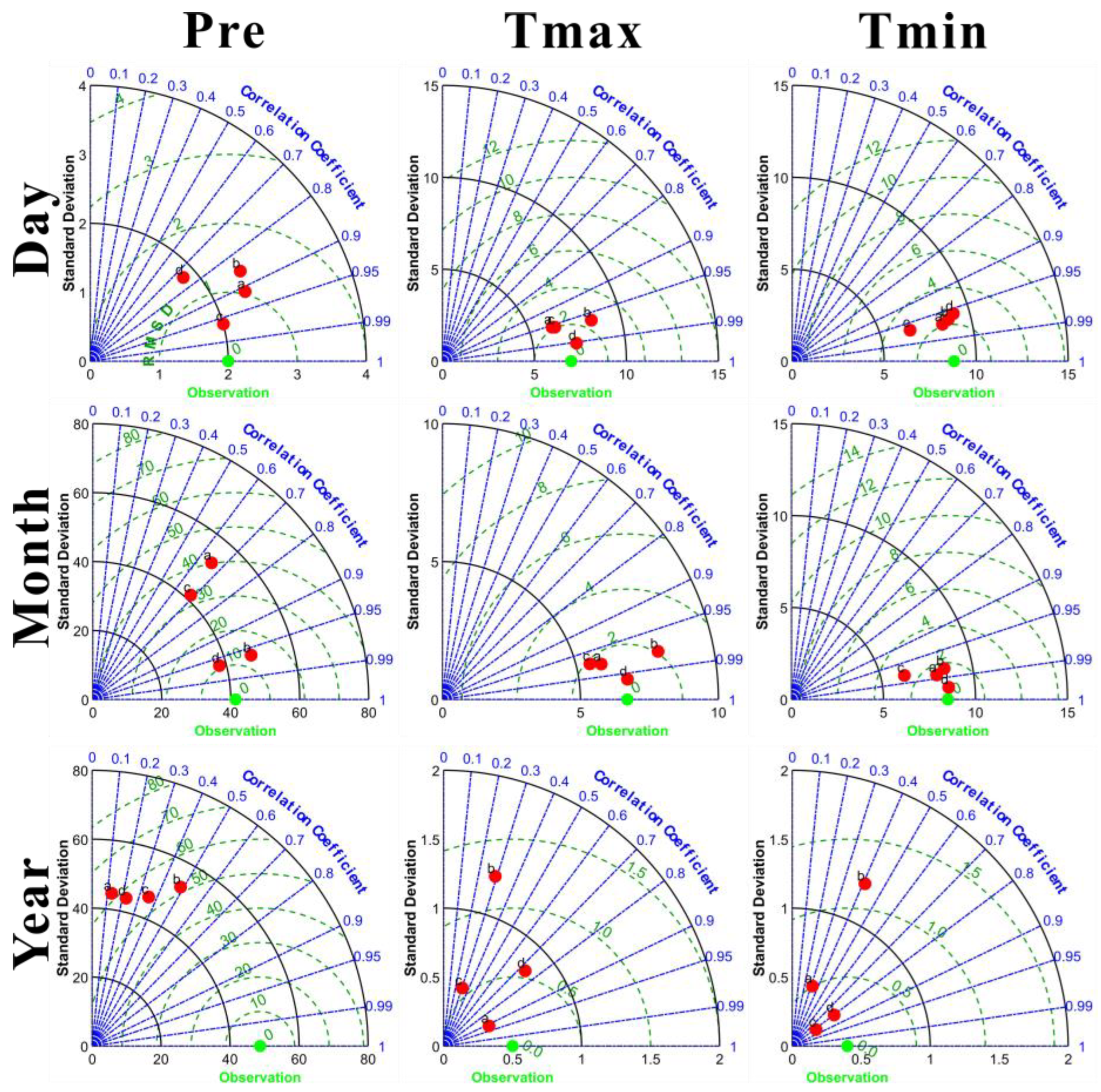
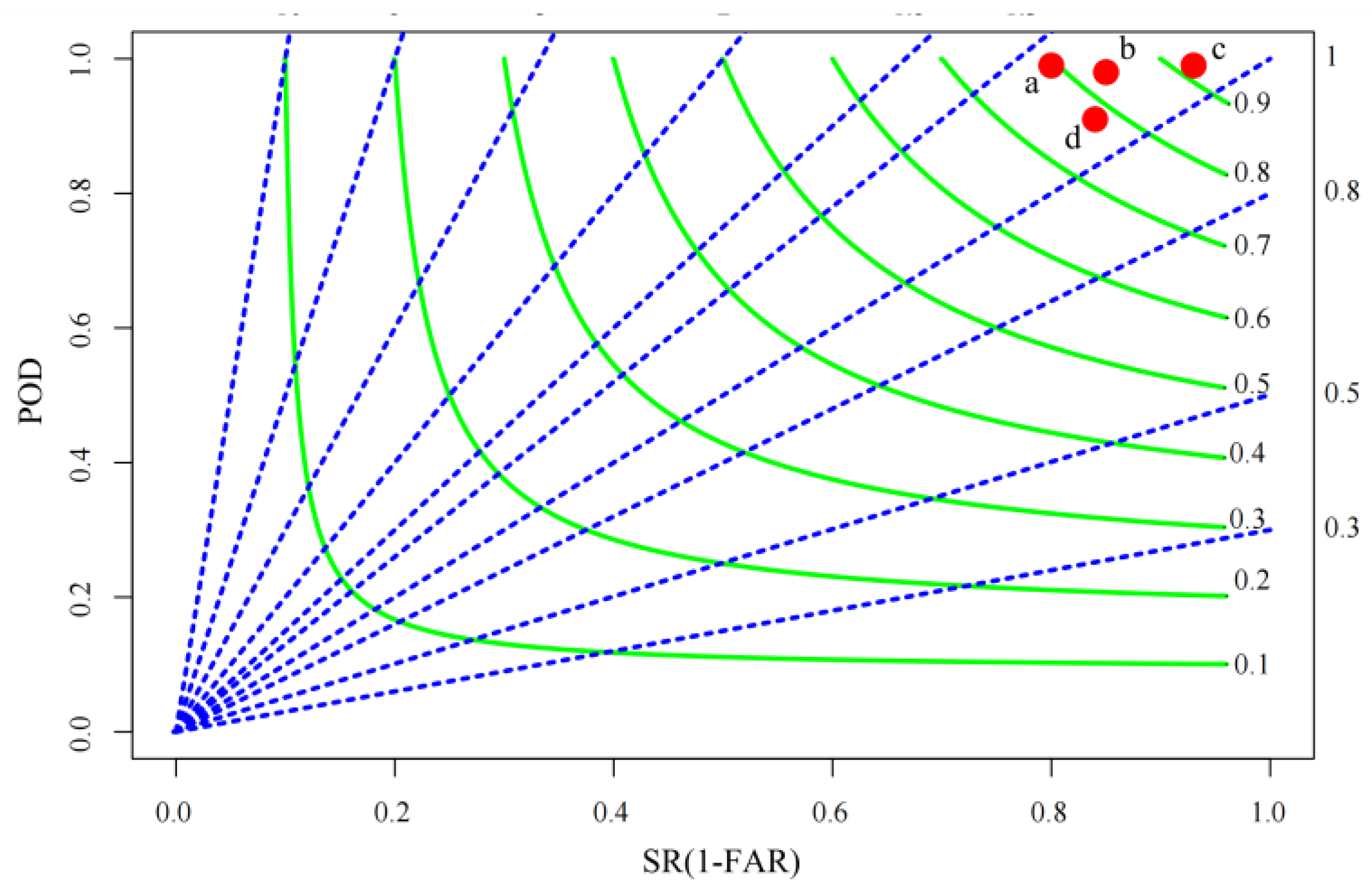
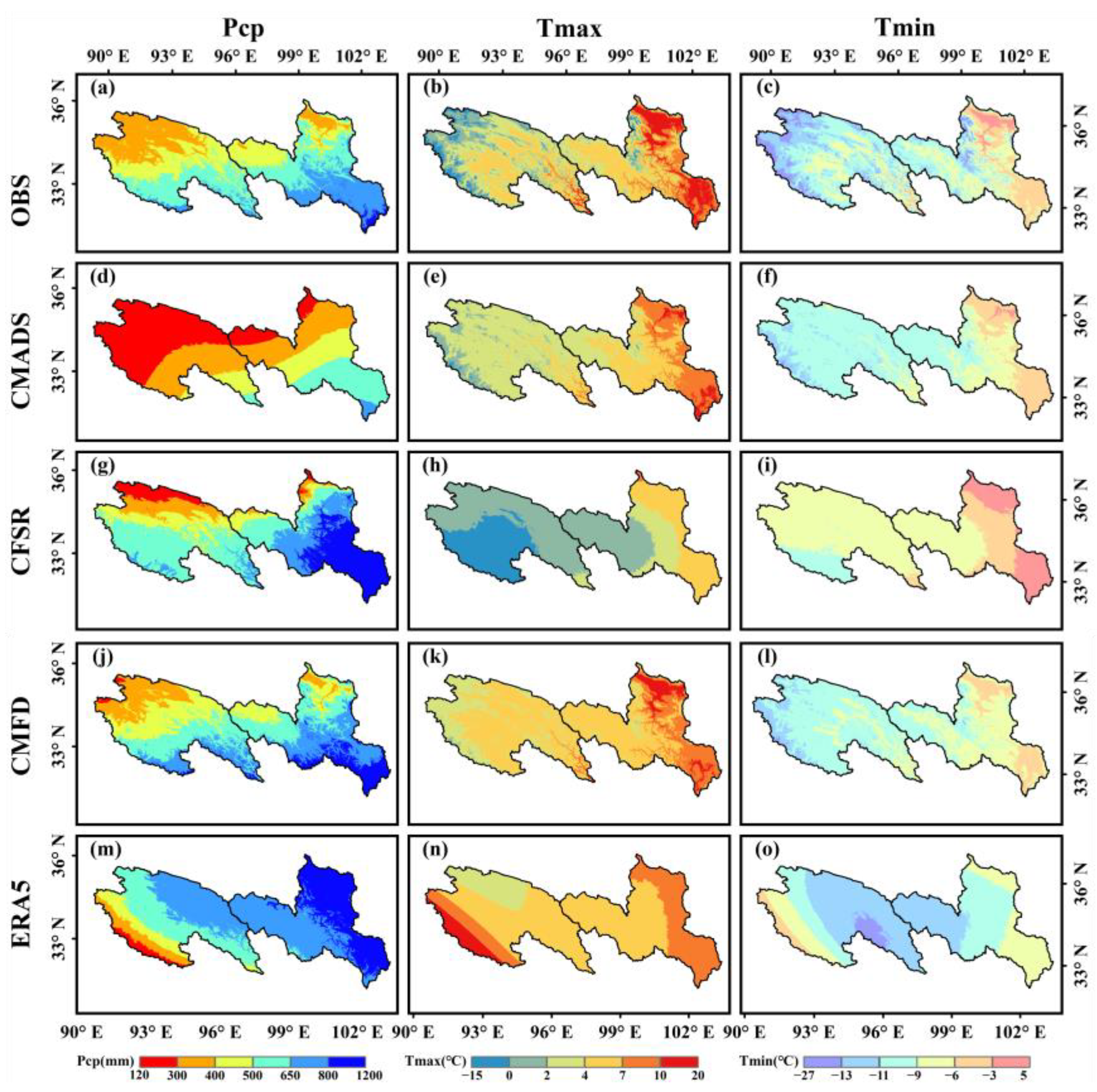
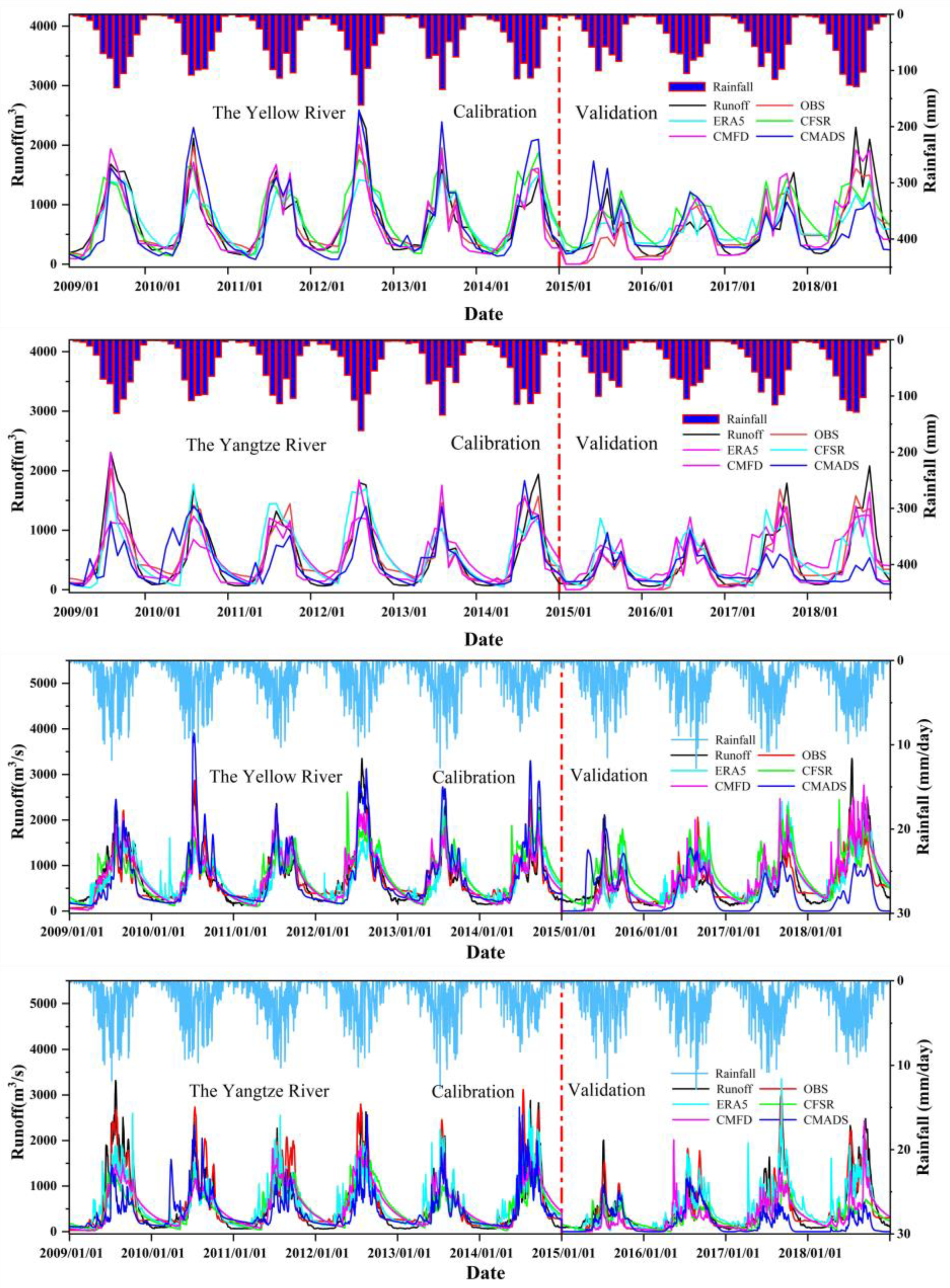
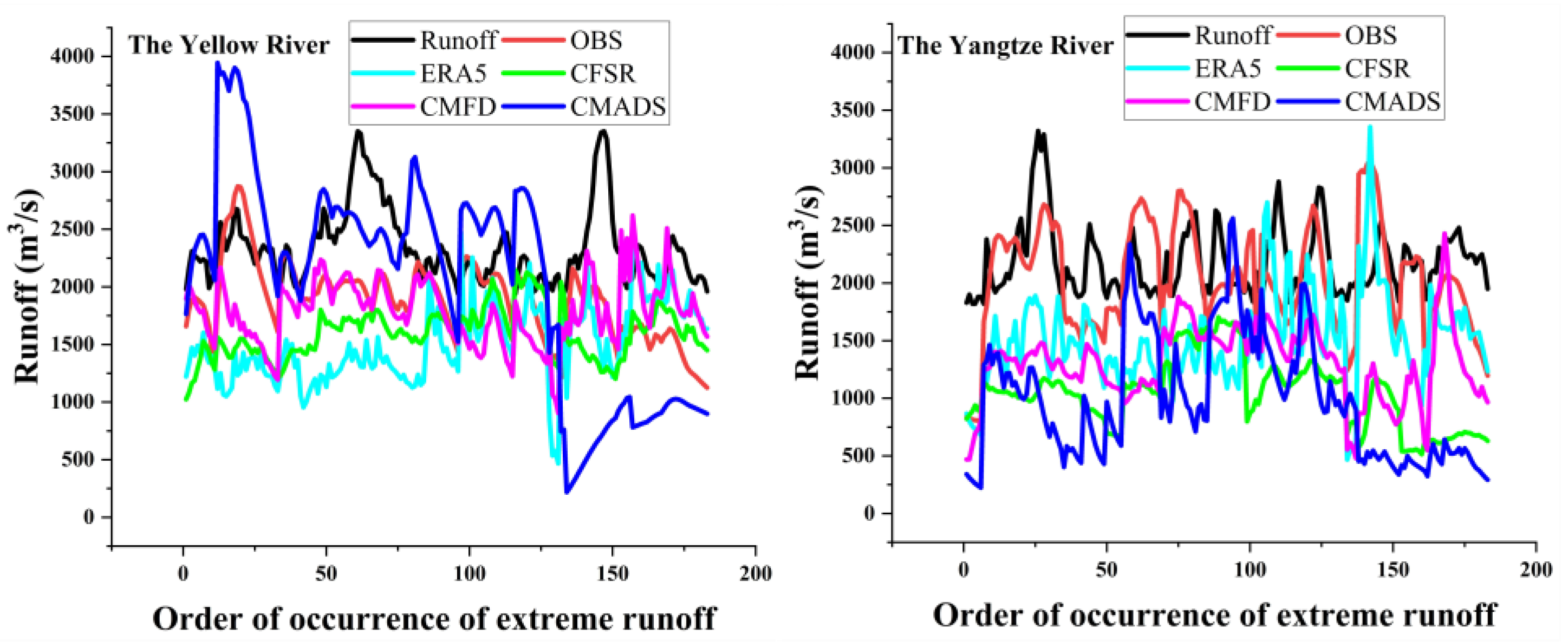

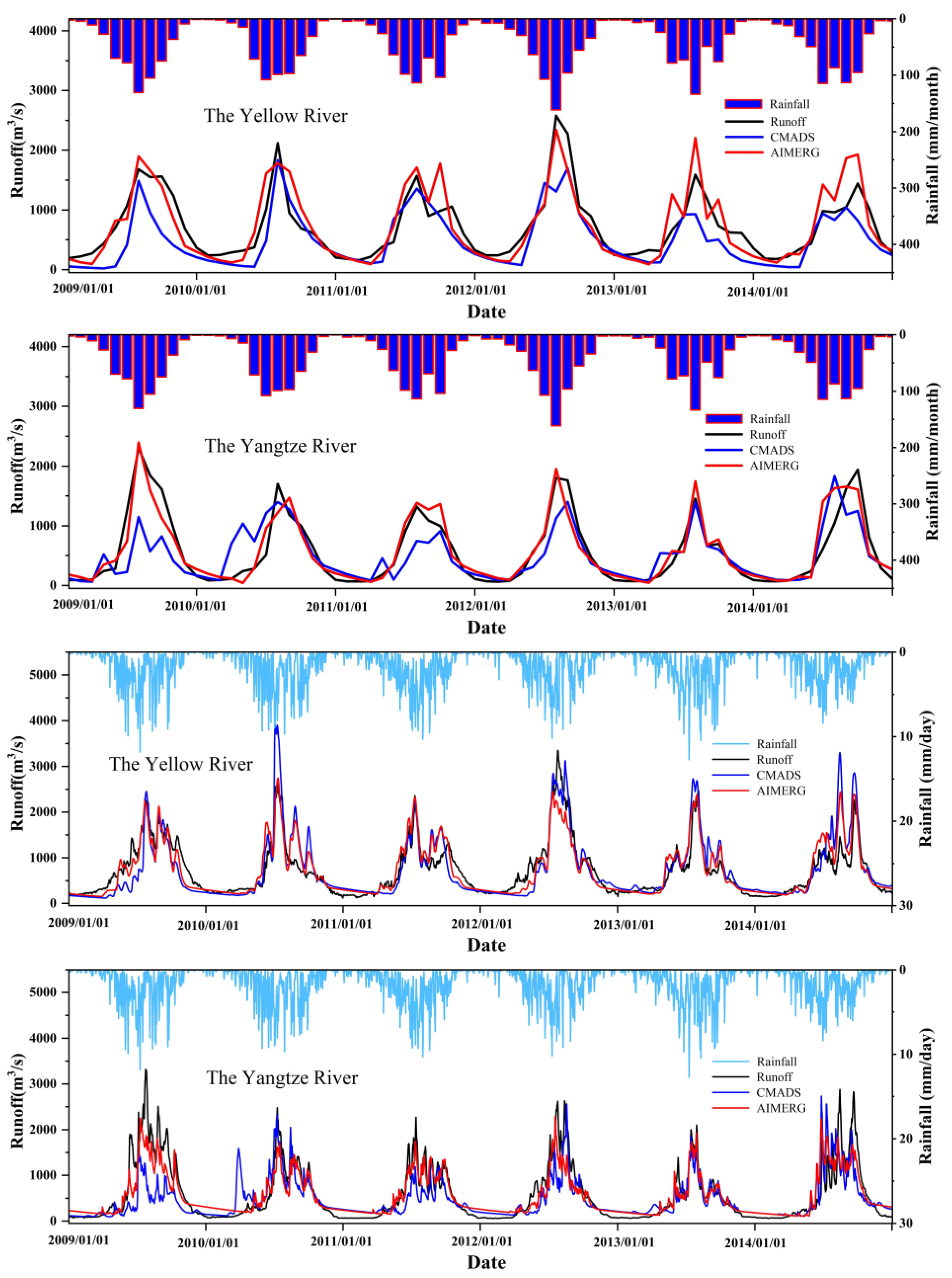
| Data Name | Time Range | Time Resoltion | Spatial Resolution | Data Sources |
|---|---|---|---|---|
| CFSR (SWAT) | 2008–2014 | daily | 1/3° | https://swat.tamu.edu/data/cfsr (accessed on 9 February 2021) |
| CFSv2 | 2014–2018 | 6 h | 0.5° | https://rda.ucar.edu/datasets/ds094.0 (accessed on 10 February 2021) |
| CMADS V1.0 | 2008–2018 | daily | 1/3° | http://www.cmads.org (accessed on 15 March 2021) |
| CMFD | 2008–2018 | 3 h | 0.1° | http://data.tpdc.ac.cn (accessed on 11 May 2022) |
| ERA5 | 2008–2018 | 1 h | 0.25° | https://cds.climate.copernicus.eu/ (accessed on 20 May 2022) |
| OBS | 2008–2018 | daily | - | http://data.cma.cn (accessed on 11 October 2020) |
| DEM | - | - | 90 m | http://www.resdc.cn (accessed on 1 October 2020) |
| LUCC | 2010 | - | 30 m | http://www.resdc.cn (accessed on 1 October 2020) |
| HWSD | - | - | 1 km | https://data.tpdc.ac.cn (accessed on 17 September 2020) |
| Hydrological data | 2008–2018 | monthly | - | Hydrological Yearbook |
| AIMERG | 2008–2014 | 0.5 h | 0.1° | https://data.tpdc.ac.cn (accessed on 25 August 2022) |
| Indicator | Very Good | Good | Satisfactory | Unsatisfactory |
|---|---|---|---|---|
| R2 | R2 > 0.85 | 0.75 < R2 ≤ 0.85 | 0.6 < R2 ≤ 0.75 | R2 ≤ 0.6 |
| NSE | NSE > 0.8 | 0.7 < NSE ≤ 0.8 | 0.5 < NSE ≤ 0.7 | NSE ≤ 0.5 |
| Name | Formula | Value Range | Ideal Value |
|---|---|---|---|
| Correlation Coefficient (CC) | −1 to 1 | 1 | |
| Standard Deviation (STD) | 0 to +∞ | 0 | |
| Centered Root Mean Square Difference (RMSD) | 0 to +∞ | 0 | |
| Probability of Detection (POD) | 0 to 1 | 1 | |
| False Alarm Ratio (FAR) | 0 to 1 | 0 | |
| Critical Success Index (CSI) | 0 to 1 | 1 | |
| Coefficient of Determination (R2) | 0 to 1 | 1 | |
| Nash-Sutcliffe coefficient (NSE) | 0 to 1 | 1 |
| Parameter | Description | Min | Max | Sensitivity | Fitted Value |
|---|---|---|---|---|---|
| R_CN2.mgt | SCS runoff curve number | −0.5 | 0.5 | 6 | 0.19 |
| V_ALPHA_BF.gw | Baseflow alpha factor (days) | 0 | 1 | 10 | 0.87 |
| A_GW_DELAY.gw | Groundwater delay (days) | −31 | 500 | 4 | 119.97 |
| V_GWQMN.gw | Threshold depth of water in the shallow aquifer required for return flow to occur (mm) | 0 | 5000 | 1 | 4394.73 |
| V_GW_REVAP.gw | Groundwater “revamp” coefficient | 0.02 | 0.2 | 9 | 0.08 |
| V_RCHRG_DP.gw | Deep aquifer percolation fraction | 0 | 1 | 3 | 0.33 |
| R_SOL_Z(..).sol | Depth of burial at the bottom of the soil layer | −1 | 10.5 | 2 | 0.91 |
| R_SOL_AWC(..).sol | Available water capacity of the soil layer | 0 | 1 | 8 | 0.62 |
| R_SOL_K(..).sol | Saturated hydraulic conductivity (mm h−1) | −1 | 19.5 | 5 | 0.59 |
| V_SMTMP.bsn | Snow melt base temperature (°C) | −5 | 5 | 7 | −3.08 |
| Time Scale | Calibration | Validation | |||||||
|---|---|---|---|---|---|---|---|---|---|
| Yellow River | Yangtze River | Yellow River | Yangtze River | ||||||
| R2 | NSE | R2 | NSE | R2 | NSE | R2 | NSE | ||
| OBS | Daily | 0.81 | 0.81 | 0.83 | 0.80 | 0.70 | 0.69 | 0.82 | 0.80 |
| CMFD | 0.82 | 0.81 | 0.76 | 0.74 | 0.70 | 0.67 | 0.62 | 0.51 | |
| ERA5 | 0.63 | 0.63 | 0.73 | 0.72 | 0.63 | 0.60 | 0.67 | 0.65 | |
| CFSR | 0.64 | 0.63 | 0.65 | 0.61 | 0.60 | 0.43 | 0.62 | 0.41 | |
| CMADS | 0.75 | 0.64 | 0.53 | 0.50 | 0.34 | 0.18 | 0.35 | 0.15 | |
| OBS | Monthly | 0.82 | 0.82 | 0.86 | 0.84 | 0.65 | 0.64 | 0.78 | 0.77 |
| CMFD | 0.80 | 0.78 | 0.80 | 0.80 | 0.65 | 0.59 | 0.75 | 0.70 | |
| ERA5 | 0.76 | 0.75 | 0.75 | 0.69 | 0.65 | 0.59 | 0.67 | 0.59 | |
| CFSR | 0.73 | 0.70 | 0.73 | 0.72 | 0.58 | 0.47 | 0.57 | 0.57 | |
| CMADS | 0.76 | 0.67 | 0.55 | 0.54 | 0.30 | 0.24 | 0.36 | 0.23 | |
| Input Data | Time Scale | Yellow River | Yangtze River | ||
|---|---|---|---|---|---|
| R2 | NSE | R2 | NSE | ||
| CMADS | Daily | 0.75 | 0.64 | 0.53 | 0.50 |
| AIMERG + CMADS | 0.82 | 0.81 | 0.82 | 0.79 | |
| CMADS | Monthly | 0.76 | 0.67 | 0.55 | 0.54 |
| AIMERG + CMADS | 0.79 | 0.72 | 0.86 | 0.86 | |
Disclaimer/Publisher’s Note: The statements, opinions and data contained in all publications are solely those of the individual author(s) and contributor(s) and not of MDPI and/or the editor(s). MDPI and/or the editor(s) disclaim responsibility for any injury to people or property resulting from any ideas, methods, instructions or products referred to in the content. |
© 2024 by the authors. Licensee MDPI, Basel, Switzerland. This article is an open access article distributed under the terms and conditions of the Creative Commons Attribution (CC BY) license (https://creativecommons.org/licenses/by/4.0/).
Share and Cite
Wang, X.; Zhou, J.; Ma, J.; Luo, P.; Fu, X.; Feng, X.; Zhang, X.; Jia, Z.; Wang, X.; Huang, X. Evaluation and Comparison of Reanalysis Data for Runoff Simulation in the Data-Scarce Watersheds of Alpine Regions. Remote Sens. 2024, 16, 751. https://doi.org/10.3390/rs16050751
Wang X, Zhou J, Ma J, Luo P, Fu X, Feng X, Zhang X, Jia Z, Wang X, Huang X. Evaluation and Comparison of Reanalysis Data for Runoff Simulation in the Data-Scarce Watersheds of Alpine Regions. Remote Sensing. 2024; 16(5):751. https://doi.org/10.3390/rs16050751
Chicago/Turabian StyleWang, Xiaofeng, Jitao Zhou, Jiahao Ma, Pingping Luo, Xinxin Fu, Xiaoming Feng, Xinrong Zhang, Zixu Jia, Xiaoxue Wang, and Xiao Huang. 2024. "Evaluation and Comparison of Reanalysis Data for Runoff Simulation in the Data-Scarce Watersheds of Alpine Regions" Remote Sensing 16, no. 5: 751. https://doi.org/10.3390/rs16050751
APA StyleWang, X., Zhou, J., Ma, J., Luo, P., Fu, X., Feng, X., Zhang, X., Jia, Z., Wang, X., & Huang, X. (2024). Evaluation and Comparison of Reanalysis Data for Runoff Simulation in the Data-Scarce Watersheds of Alpine Regions. Remote Sensing, 16(5), 751. https://doi.org/10.3390/rs16050751







